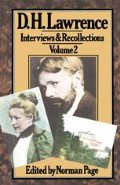Abstract
… I saw on Saturday afternoon D. H. Lawrence and his fat German spouse Frieda and the great decaying mushroom Middleton Murry and an attendant toadstool called Dr Young1 at Brett’s2 house in Hampstead. I went up there to say goodbye to Brett, but found to my dismay this dreadful assembly of Adelphites.3 Lawrence was very rude to me, of course, and held forth to the assembly as if he was a lecturer to minor university students. Apparently he came back this winter expecting to be greeted as the new messiah. Unfortunately very few saw his divination. The great Dunning4 almost denied it. A few critics called him a genius but that wasn’t enough. ‘England is rotten, its inhabitants corrupt.’ Mexico is the only country where prophets, and great writers are appreciated. So tomorrow Lawrence, and Frieda and Brett set off in an ocean liner for Mexico.
From Carrington: Letters and Extracts from Her Diaries, ed. David Garnett (London: Jonathan Cape, 1970) pp. 283–4.
Access this chapter
Tax calculation will be finalised at checkout
Purchases are for personal use only
Notes
Dora de Houghton Carrington, English painter born in 1893, preferred to be known by her surname. She was educated at the Slade School and became a close friend of Lytton Strachey—see Michael Holroyd, Lytton Strachey: A Critical Biography, II (London: Heinemann, 1968) passim. She committed suicide in 1932. The extract given above is taken from a letter to Gerald Brenan dated 4 March 1924; the meeting with Lawrence had taken place on I March. Dorothy Brett was also present and has given a brief account of the same tea-party (Lawrence and Brett, p. 28). It concludes, ‘Carrington takes you [Lawrence] aside and begins archly to ask you about flowers. You are looking at her keenly. And I think you used her later in your story, “None of That”.’ In the story referred to (in the volume The Woman who Rode Away) Carrington appears as Ethel Cane; Aldous Huxley had also depicted her as Mary Bracegirdle in Crome Yellow (1921).
Editor information
Editors and Affiliations
Copyright information
© 1981 Palgrave Macmillan, a division of Macmillan Publishers Limited
About this chapter
Cite this chapter
Carrington, D. (1981). In Hampstead. In: Page, N. (eds) D. H. Lawrence. Interviews and Recollections. Palgrave Macmillan, London. https://doi.org/10.1007/978-1-349-04823-6_12
Download citation
DOI: https://doi.org/10.1007/978-1-349-04823-6_12
Publisher Name: Palgrave Macmillan, London
Print ISBN: 978-1-349-04825-0
Online ISBN: 978-1-349-04823-6
eBook Packages: Palgrave Literature & Performing Arts CollectionLiterature, Cultural and Media Studies (R0)

